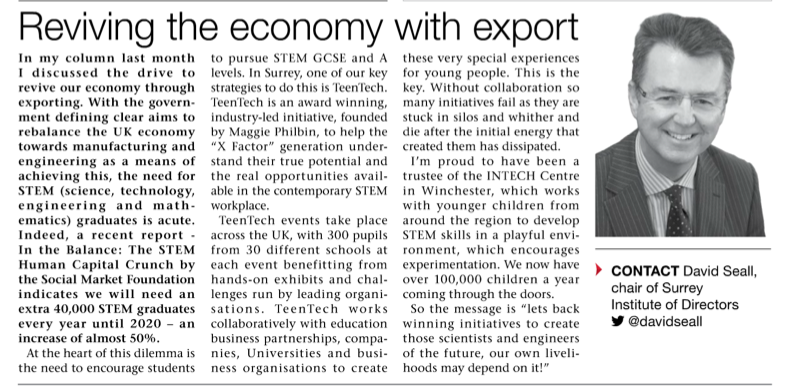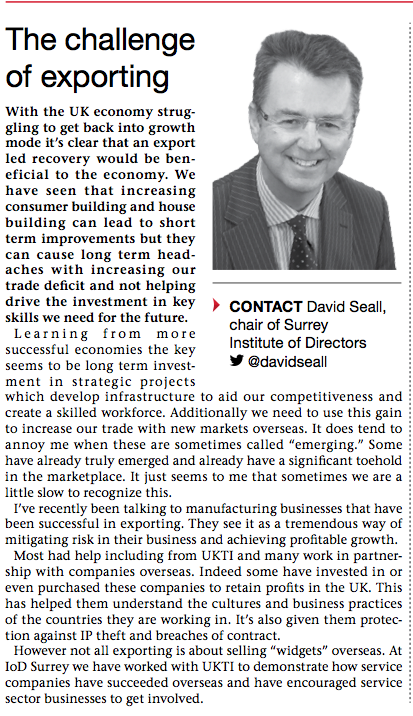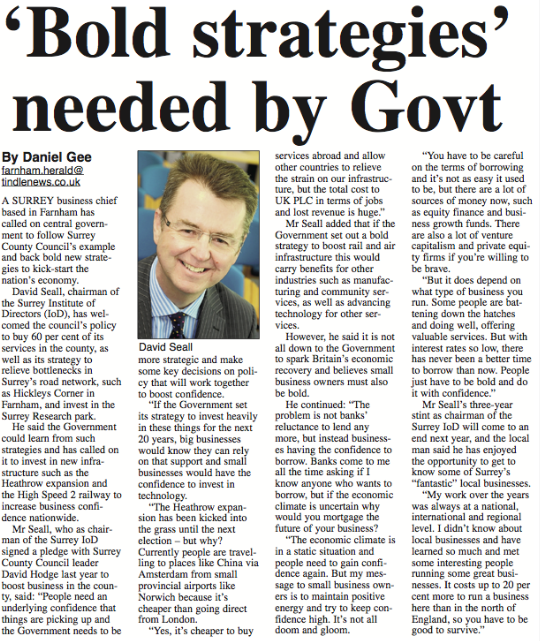
Developing Acquisition Criteria: A Checklist for Identifying Target Companies
I recently interviewed a leading UK defence company on their views on the current M&A market and how they selected suitable companies to acquire.
The findings are here.
New Blogs on the DMH Stallard Business Beanstalk
I’ve recently been blogging about lean and other things on the DMH Stallard Business Beanstalk
Please follow the links to get to the story
http://businessbeanstalk.net/2013/03/21/a-lean-mean-business-machine
http://businessbeanstalk.net/2013/03/28/a-lean-office
http://businessbeanstalk.net/2013/06/11/i-dont-want-to-go-lean
More to follow…
Information waste in the office environment
Information waste in the office environment
In my recent blog about “lean” I discussed the various ways that waste can be defined and how to identify non-value adding activities.
In my experience of lean the emphasis is often on activities in obvious places such as the factory floor and yet other areas of the enterprise seem to escape. It seems strange that attention is made of getting goods out of the factory quickly and efficiently and yet paperwork and office systems escape with little analysis or reform.
In a rudimentary way we can identify the main areas of waste in an office environment. I’m sure that we’ve all experienced most of these in our working lives.
Bottleneck departments
Areas where the processes are often poorly defined and inefficient so “log jams” occur. Perhaps if the process has been made efficient, there is just insufficient resource to make it happen.
Lots of validation checks – multiple signatures
Sometimes there are just too many people in the approval process and most not adding value in any way. Managers hold things up through procrastination, by being a signatory although they don’t actually evaluate the subject matter (sometimes through just wanting the status that goes with it!), or by just not being there to sign when required.
As an example, we all know how impossible it is to raise a cheque within a business!
Over complex
Processes that are far too complicated. Especially those which have been developed iteratively over time that add little value. Perhaps the processes have not been developed by the people that actually do the work but by a well meaning, or controlling, manager.
Multiple uncontrolled documents in circulation
A lack of document control or a system that isn’t followed because of ill discipline and no “buy in” from employees. Perhaps it’s a process that’s just too unwieldy and complicated to work. Paper copies are often produced that are soon out of date and that may have been superceded by newer ones that are probably electronic. This leads to major risks of poor decision making in the organisation.
Of course multiple copies of electronic documents are made that often clog up servers with duplicates or various revisions. Copies are kept within “outlook” folders. Data is also transferred to Excel spreadsheets for analysis purposes where the document is uncontrolled and often the formulae are not checked.
Batching of documents
Work piling up in in-trays waiting to be processed or for the person to find time to do it. This builds up a pile of inventory. Additionally, in the digital world, emails remain unanswered and filling up “to do” folders in personal outlook inboxes.
Always best to process and move it on without delay!
High levels of data re-entry and re-keying
Incompatible systems relying on multiple data entry to make things happen. Very little value added and a very depressing job to have to do. A major area where mistakes are made leading to re-work.
Production of reports that nobody uses
Overlong, complex reports that are either too complicated or are full of irrelevant information. The reports often take so long to compile that they are not part of the decision making process, as they are too late. Even worse is that some people take time out to read them!
Sometimes are measures brought in that aren’t used by management to measure progress in the business and aren’t related to achieving the business plan. These often have no relation to policy deployment.
Fast track routes that slow-up everything else
Managers or persuasive employees by-passing the proper processes to get their jobs done first. We have all met “he who shouts loudest gets his job done first”. Often the more important tasks are then behind schedule and not completed on time.
Personal filing systems
Official company wide systems such as the Client Relationship Management (CRM) not being used. Addresses then being kept on Excel spreadsheets, in Outlook contacts, business card books or other databases, particularly on smart devices. Paper filing systems in cabinets or desks which are locked or are not understood by anyone else.
Unpredictable processing lead-times
Work taken on without a defined process or when ”guestimated” without proper analysis.
So we can see that there’s an inordinate amount of wasteful activity going on in most office environments.
What’s really dangerous is that it’s often difficult to see and the effects difficult to measure. Additionally these wastes add significantly to the cost base but also affect cash flow and the overall delivery performance of the business.
I expect it’s time for companies in all sectors, not just manufacturing, to get with the “lean” revolution and reduce waste and improve efficiency in their office environment!
Further information on “lean” can be found at www.fedden-usp.co.uk where I am retained as a Board Advisor.
The trials and tribulations of exporting and working overseas
We are told that the way to salvation for the UK’s stagnating economy is for all businesses to export. Additionally it’s not just to our fellow members of the EU but also to the emerging markets around the world.
One could say that these markets have already “emerged” and have substantial economies of their own. In fact many UK businesses lag far behind our competitors in Germany, France, Italy and the USA in creating a presence in these countries. The irony is that some of them are the very Commonwealth countries we turned away from back in the seventies.
The key aspect is that these economies are still growing at some rate and undoubtedly have an appetite for the goods and services that we can provide. An interesting statistic is that China will soon overtake USA as the biggest market for Rolls Royce Motor Cars.
Notwithstanding the challenges facing the service sector, If we focus on manufacturing and engineering businesses, which most would agree have considerable potential to export, how do we encourage companies that see themselves as integral to UK based supply chains to export to new markets?
Since 2008 many businesses have recognised the burning platform of a UK and EU based sales pipeline and, aided by some preferential exchange rates have begun or expanded their exporting efforts. Also firms have been working with partner companies abroad to offshore production or add extra capabilities to their business.
I’m currently working on my next DMH Stallard thought leadership project to explore how companies have made a success of exporting in new markets and developing new capabilities and what they have learned both positively and negatively from the experience.
The report will be published in the Spring and will, as always, disseminate best practice to help businesses benchmark themselves with their peers.
Partnerships in Surrey
Looking back on the Olympic games I’m sure we are all pleased with the way the Olympic events reflected on the County. Although the mens’s road race didn’t go to plan, or the rest didn’t follow our plan! The other events went extremely well with literally hundreds of thousands of spectators lining the routes to cheer on all of the competitors and celebrate a Gold and Silver medal for Team GB.
This has been a significant success for all of those, public or private sector, that organised and facilitated the events and showed the world what Surrey can do. We now have to build on this success and increase the economic performance of the County.
As some of you will know, we have two recognized LEPs in the County “Enterprise M3” covering the West, along with most of North and Central Hampshire and “Coast to Capital” covering East Surrey, Croydon, the “Gatwick Diamond” and most of West Sussex. We are engaged at senior level with both of these groups to make sure that the interests of IoD Surrey members and the business community at large are promoted.
Additionally we are working closely with Surrey County Council and “Surrey Connects” to help them with their ambitious plans to help grow the local economy. We at IoD Surrey have recently agreed a partnership agreement aimed at boosting business in the County.
Surrey County Council has pledged to spend 60 percent of its spending on goods and services with businesses based in the County and we will be hoping to run an event for members to engage with this process in the Autumn. As well as committing to support “super fast Broadband” in the County, SCC has also announced that it will help fund 200 new apprenticeship positions in the County by offering a cash incentive of £1500 to companies taking on a new apprentice. This is in addition to the £1500 Government grant currently available. More details of this can be found on the IoD Surrey LinkedIn Group page. Schemes like these are vital to attempt to combat the scourge of Youth unemployment and I urge IoD members to do their best to get engaged and support this.
It’s clear that we will struggle to get central government support, as this has been the case regardless of the particular hue of the government of the day. There’s certainly no point wasting energy in complaining. It’s refreshing to see an approach based on practical commitments to work with local businesses taking hold and I’m sure we can all get involved and take this forward in a spirit of partnership.
The misappropriation of “lean”
One of the frustrating things about the “lean revolution” that has occurred in manufacturing and other sectors over the last 20 years or so has been the misappropriation of the term “lean”.
I have heard countless business leaders refer to their operation as being “lean” or “leaned up”, when in many cases all that has been done is a progressive or sometimes catastrophic cutting of overhead to reduce costs. This is exemplified by the traditional focus on maintaining “direct” workers – those that are directly employed doing “productive activity” and the hacking into “indirects” who support and sometimes supervise these employees.
This is often done with no analysis of how processes work within the company. So it’s often the case that the “indirect” is dispensed with but the jobs they do are not. Not surprisingly it falls upon the “directs” to now do these tasks and lo and behold productivity of these employees drops and quality suffers. Additionally, more often than not, delivery deadlines are missed and customer relations suffer.
Of course it’s much easier to optimize processes and improve efficiency in growth times when a business is trying to do more with the same resource. It’s much more difficult, and emotionally draining, to do it when a business is trying to deliver the same with less resource.
One of the key rules drilled in to me during my initial journey into “lean” was “if your customer knew you were doing this- would they be prepared to pay you to do it?”
It’s a good example because it focuses on what “lean” is really about. It’s about focusing on the productive and therefore valuable things your customer is prepared to pay for and removing the wasteful things that they would not be.
For those not familiar with the concept, the world leaders in lean- Toyota (in fact it’s often called the Toyota model) characterise waste or “muda” in seven ways.
Transportation
Each time a product is moved it stands the risk of being damaged, lost, delayed, etc. as well as being a cost for no added value. Transportation does not make any transformation to the product that the consumer is willing to pay for.
An example of this was a company I once saw shipping items 80 miles away to a sister plant for a couple of tasks and then shipping them all the way back again. Moving the process to the main factory eliminated this. However it’s surprising how far things can move in one factory or office.
Inventory
Inventory, be it in the form of raw materials, work-in-progress (WIP), or finished goods, represents a capital outlay that has not yet produced an income either by the producer or for the consumer. Any of these three items not being actively processed to add value is waste.
Of course this stuff also takes up productive waste. One often sees stores full of stuff waiting to go out on the shop floor. Think of all of those brochures sitting in the office or storeroom because it was “cheaper” to buy 2000. Multiply that several times and see how much stuff a business has paid for and how much productive space it’s occupying. Modern supermarkets are a great example of how to get this right. Goods inwards and store space is kept to a minimum. Products are delivered on a “just –in-time” basis. When things arrive they go straight out into the shop to be sold.
Motion
In contrast to transportation, which refers to damage to products and transaction costs associated with moving them, motion refers to the damage that the production process inflicts on the entity that creates the product, either over time or during discrete events.
This could be wear and tear on equipment, RSI for workers or accidents and specific injuries on site
Waiting
Whenever goods are not in transport or being processed, they are waiting. In traditional processes, a large part of an individual product’s life is spent waiting to be worked on.
This doesn’t only include physical components or goods, it could include emails in the inbox – or worse a “folder” or paper piling up in the in tray!
Over-processing
Over-processing occurs any time more work is done on a piece than what is required by the customer. This also includes using tools that are more precise, complex, or expensive than absolutely required.
Doing more than the customer expected and sometimes more than they actually wanted and using a sledgehammer to crack a nut!
Over-production
Overproduction occurs when more product is produced than is required at that time by your customers. One common practice that leads to this muda is the production of large batches, as often consumer needs change over the long times large batches require. Overproduction is considered the worst muda because it hides and/or generates all the others. Overproduction leads to excess inventory, which then requires the expenditure of resources on storage space and preservation, activities that do not benefit the customer.
A good example of this is the clothing retailers who work hard to guess what lines will sell well and sometimes get it catastrophically wrong (I’m sure that lime green double breasted cardigan would sell- now we have 10000 of them!). They are under massive pressure from on-line retailers constantly monitoring demand and placing small orders for small batches to suppliers and delivering what the customer wants quickly and has the advantage of constantly updating their range of clothing on offer. Instead of “just in time” , overproduction is “just in case”!
Defects
Whenever defects occur, extra costs are incurred reworking the part, rescheduling production, etc.
Pretty self explanatory- why would a customer pay for you to fix the part they ordered or rework the document, correct the spelling mistakes etc? A hidden aspect is the effect on morale when employees are constantly having to fix things that should have been made correctly. One can think of the old days of British Leyland where cars went into a holding bay after they came off of the line for rework and fixing- totally non-value adding.
There is an “eighth waste” often referred to which is the waste of human talent. In fact it’s the waste that often hinders the resolution of the other seven wastes. Management that are prepared to “let go” and allow their employees to put their energies into innovating and creatively solving problems often reap the rewards.
The key is to address wasteful processes and procedures and change the way the business does things. Often those employed in the business have recognized this for years but have not been given the chance to change things.
It’s been proven that the techniques used to eliminate these wastes not only improve the bottom line performance of businesses, regardless of their sector. It also improves delivery performance and makes the company more marketable.
Having recently joined Fedden USP as Board Advisor http://www.fedden-usp.co.uk I will be regularly blogging on how businesses can improve and detailing experiences of how this has happened in the work place.





Recent Comments